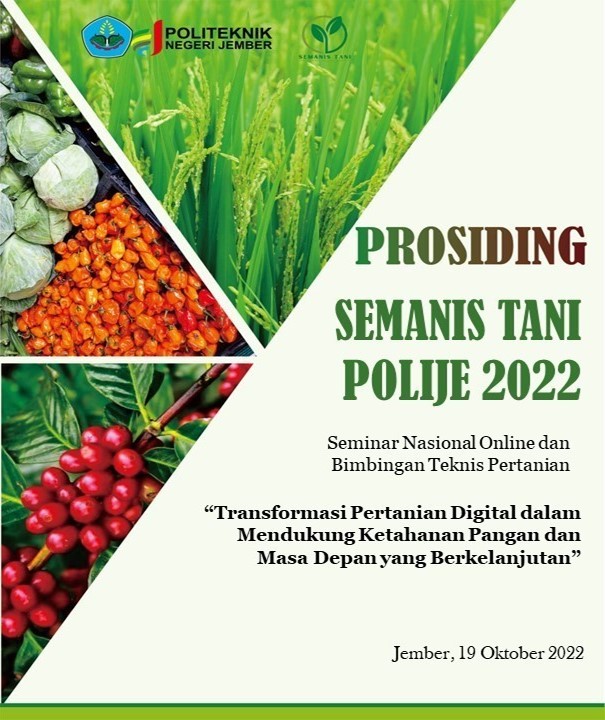SISTEM MANAJEMEN PEMUPUKAN TANAMAN MENGHASILKAN KELAPA SAWIT (Elaeis guineensis Jacq) STUDI KASUS : KEBUN PABATU PT. PERKEBUNAN NUSANTARA IV
DOI:
https://doi.org/10.25047/agropross.2022.318Kata Kunci:
Fertilizer, Garden, Management, Palm oil, TMAbstrak
Fertilization is a very important factor to increase production. The application of a good fertilization management system will affect the effectiveness and efficiency of the use of fertilizers for oil palm producing plants. The research was conducted at Pabatu Gardens PT. Perkebunan Nusantara IV, Serdang Bedagai Regency, North Sumatra Province, from February to May 2021. The purpose of the study was to determine the management of plant fertilization to produce oil palm. This study uses a qualitative descriptive method by collecting primary data from questionnaires through interviews and secondary data collection. The sampling technique used the snowball sampling method. The results showed that the fertilization management system consisted of (1) Planning (Planning) its activities consisting of (a) making a Corporate Budget Work Plan (RKAP) which is an annual work plan in the plantation; (b) Leaf Sampling (KCD); (c) Fertilizer recommendations; (d) Field Preparation; (e) Personal protective equipment and equipment (PPE); (f) Transportation. (2) Organization (Organizing) includes the division of fertilization work which consists of 24 Kindergartens which are divided into 4 groups. Each group consists of 5 TK sowers and 1 TK retailer. (3) Actuating whose activities consist of preparation of fertilization, application of fertilization and realization of fertilization. (4) Supervision (Controlling) is carried out with a direct system. Based on field observations, data obtained that the realization of fertilization in Semester I of 2020 was below the fertilizer recommendation, this was due to the availability of fertilizer in the warehouse and the low intensity of rainfall.
Unduhan
Referensi
Budiargo, A; Puoerwanto, R. S. (2015). Manajemen Pemupukkan Kelapa Sawit (Eleais Guineensis Jacq) Di Perkebunan Kelapa Sawit. Institut Pertanian Bogor.
Dharma, S. (2018). manajemen Kinerja : Falsafah Teori dan penerapannya. Pustaka Pelajar.
GAPKI. (2020). Kinerja Industri Sawit Indonesia 2019. https://gapki.id/kinerja-industri-sawit-indonesia.
Lubis, R.E; Widanarko, A. (2011). Buku Pintar Kelapa Sawit. Agromedia.
Mey, M. (2021). Realisasi Pemupukan dan Produksi Kelapa Sawit di PT. Jaya Mandri Sukses. Buletin Loupe, 17(02), 140–145. https://doi.org/10.51967/buletinloupe.v17i02.646
Panggabean, S. M., & Purwono. (2017). Manajemen Pemupukan Tanaman Kelapa Sawit (Elaeis Guineensis Jacq.) Di Pelantaran Agro Estate, Kalimantan Tengah Management of oil palm fertilization in Pelantaran Agro Estate, Center Kalimantan. Bul. Agrohorti, 5(3), 316–324.
Prasetyo, D.W; Kramaja, M. N. F; Wandri, R; Asmono, D. (2018). Performa Tanaman Kelapa Sawit Pada Musim Kering Di Sumatera Selatan. In Prosiding Seminar Nasional Lahan Sub Optimal: Pengaruh Pemupukkan Terhadap Pertumbuhan Vegetatif Dan Status Hara Tanaman, 60–66.
Sembiring, A. M. (2017). Analisis Faktor-Faktor Yang Mempengaruhi Kinerja Karyawan Panen Di Kebun Tanjung Kasau. Universitas Sumatera Utara.
Subhani, A; Tariq, M;, Jafar, M.S; Latif, R; Khan, M; Iqbal, M. S. (2012). Role Of Soil Moisture In Fertilizer Use Efficiency For Rainfed Areas-a Review. Of Biology, Agriculture And Healthcare, 2(11), 1–9.
Sugiyono. (2018). Metode Penelitian Kuantitatif, Kualitatif dan R&D. Alfabeta.
Wahyuni, M. (2013). Kajian Biaya Aplikasi Pemupukan Pada Tanaman Menghasilkan Kelapa Sawit (Elaeis guineensis Jacq) Di Kebun Tanah Gambus PT. SOCFINDO. Jurnal Penelitian STIPAP, 3(2), 55–68.
Unduhan
Diterbitkan
Cara Mengutip
Terbitan
Bagian
Lisensi
Hak Cipta (c) 2022 Tuty Ningsih, Rizki amalia, Aldo Rinaldo Sitorus

Artikel ini berlisensi Creative Commons Attribution 4.0 International License.
Hak cipta (Copyright) artikel yang dipublikasikan di Agropross : National Conference Proceedings of Agriculture dipegang oleh penulis (Copyright by Authors) di bawah Creative Commons Attribution 4.0 International License (CC-BY). Sehingga penulis tidak memerlukan perjanjian pengalihan hak cipta yang harus diserahkan kepada redaksi.






